Invisalign – Boston, MA
Straighten Your Teeth Without Wires and Brackets
Many adult patients incorrectly assume that they’ve missed the boat on straightening their smiles and correcting noticeable gaps and misalignments – after all, traditional braces are typically the domain of middle school and high school students. At Devonshire Dental of Boston, we’re happy to let you know that traditional braces aren’t the only option available for creating your best smile! Our dental office features Invisalign, an orthodontic service that trades the old wire-and-bracket model for a sleeker, more cosmetically friendly option that’s perfect for polished professionals. Contact our dental office today to schedule your first consultation to discuss Invisalign in Boston, MA.

Why Choose Devonshire Dental of Boston For Invisalign?
- Certified Invisalign Providers
- Perfect For Adults & Teens
- Located In The Financial District
How Invisalign Works
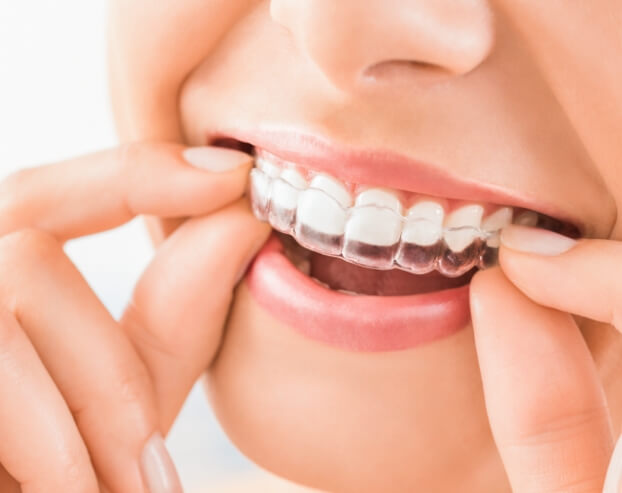
Invisalign treatment relies on the use of clear aligners to create the desired smile improvements. Using our impressions of your unique mouth, the Invisalign laboratory creates a series of these aligners, with each one representing a different stage of your teeth as they’re gradually shifted towards the proper position. The patient’s job is to wear each aligner as directed for a set period (usually 2 weeks) and then switch to the next aligner in their unique set. During this time, you will also be visiting our dental office at regular intervals so that we can ensure that things are moving correctly.
Who Can Invisalign Help?

Now that you know a little more about how Invisalign works, you might be wondering, “Am I a candidate?” To find out, schedule a consultation with our Boston dental team so we can conduct a comprehensive oral exam. In the meantime, read on to learn several orthodontic issues that can be addressed with clear aligners:
Crowded Teeth
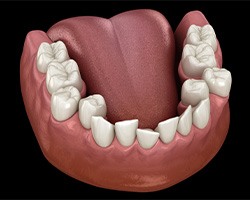
Having crowded teeth can take a toll on your self-esteem. Plus, this orthodontic problem can interfere with your cleaning routine, increasing your risk of dental health issues like gum disease and tooth decay in the process. The good news is, if you’re a candidate for Invisalign, we can craft custom clear aligners to gradually shift your teeth into a more ideal position.
Gaps Between Teeth
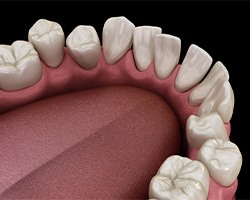
While gaps in your teeth might simply feel unappealing, they can also make you more susceptible to cavities and infection. This is because food particles can easily get stuck in the spaces between your pearly whites, leading to decay and bad breath. Fortunately, Invisalign aligners can effectively push your teeth closer together and into a healthier position for an attractive smile.
Overbite
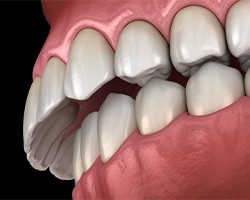
Do your top teeth jut out considerably beyond your bottom ones? Then you might have an overbite. This orthodontic problem can make it difficult to chew and enunciate properly. Of course, there are other consequences too, including persistent jaw pain and TMJ dysfunction, which is why we recommend exploring your treatment options, like Invisalign, sooner rather than later.
Underbite
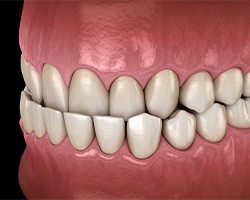
What if you have the opposite problem: your bottom teeth sit in front of your top teeth? This is referred to as an underbite, and, like the others mentioned on this list, it can negatively impact the look, health, and function of your smile. Fortunately, Invisalign can often correct mild to moderate cases with the help of rubber bands and buttons. So, the healthy, happy smile you deserve is closer than you think!
Crossbite
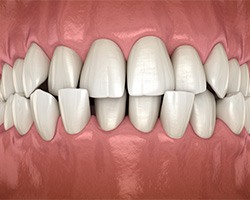
A crossbite is when a few of your bottom teeth sit in front of your top ones, creating a mixed bite. In addition to the other concerns we mentioned here, like chronic jaw pain, premature wear and tear on your teeth are another consequence of this orthodontic problem. So, if you haven’t already, schedule a consultation with us to find out if you’re a candidate for Invisalign. If you are, then we will move your teeth and bite into proper alignment as comfortably and discreetly as possible.
Open Bite
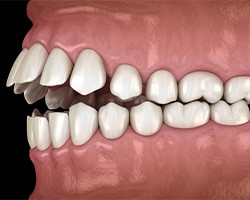
The last orthodontic problem on this list is open bites, which is when there is a space in the front or back of your mouth, preventing you from biting down properly. If left unchecked, this can cause issues like TMJ disorder and teeth clenching/grinding. So, don’t wait – schedule an appointment with us to explore your treatment options before the look, health, and function of your smile suffers.
Why Should I Choose Invisalign?
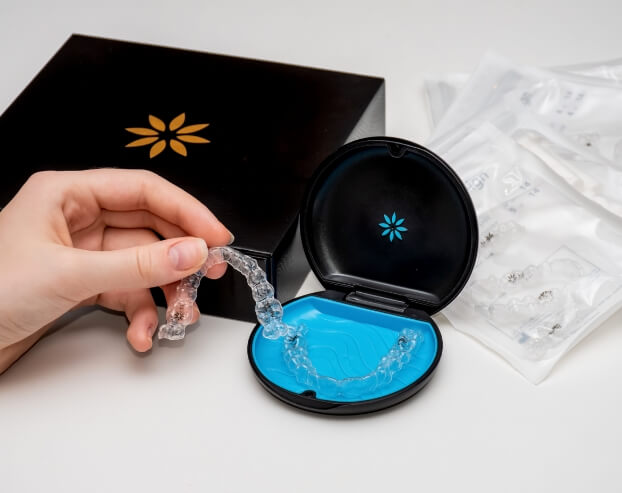
If you’re interested in maintaining a natural appearance during your orthodontic treatment, Invisalign is the best option available. The clear aligners blend in well with your smile and are barely noticeable by a passerby. Your Invisalign aligners are also removable, which means that patients can continue to enjoy all of their favorite foods without worry. Instead of dealing with irritation from orthodontic wires, patients can enjoy added comfort with customized and smooth plastic aligners. Every case is different, but most patients will be finished with Invisalign treatment somewhere between 6-18 months, which is superior to the typical multiple-year process of traditional braces.
Invisalign Teen

Do you have a teenager who is self-conscious about their smile? Do they need orthodontic treatment but want to avoid metal braces? While Invisalign is commonly used to help straighten adult smiles, it is equally helpful for mature teens. Instead of forcing them to experience embarrassment and dissatisfaction with traditional orthodontics, allow our team to provide a clearer solution that can move their teeth into place without compromising their appearance.
How is Invisalign Teen Different?
When it comes to comparing traditional Invisalign to Invisalign Teen, two main differences exist: indicator dots and replacement trays. Unlike regular clear aligners, Invisalign Teen trays come with blue indicator dots. These are designed to help with compliance. The more your teenager wears their aligners, the color will begin to fade, ensuring you and our team that appropriate wear time is being achieved. If they appear blue during a regular follow-up appointment, we will need to discuss your teen’s commitment to treatment.
Also, Invisalign Teen comes with multiple replacement trays. Since they are always on the go, there is a chance they might lose an aligner during treatment. If this happens, we can provide a new one at no additional charge. However, if they continue to lose or damage their aligners, you will be required to pay for replacements over time.
Is Invisalign Right for Your Teen?
The only way to know for sure if your teen is a good candidate for Invisalign treatment is to schedule an appointment with our team. The comprehensive oral exam we conduct allows us to determine the severity of their dental issues and determine if these clear aligners will be enough to fix the problem and produce beautiful results.
If your teenager suffers from mild to moderate overcrowding, crookedness, gaps between teeth, or bite misalignment, there is a good chance they will be eligible for Invisalign Teen. However, they must also be responsible enough to wear the trays 20-22 hours a day if they do not want to face a setback during treatment.
The Benefits of Invisalign Teen
While it might seem that the greatest benefit of Invisalign Teen is its discreetness, there are other unique advantages you and your child can expect, such as:
- An easy-to-maintain form of treatment that only requires a soft-bristled toothbrush, lukewarm water, and clear soap for cleaning.
- The ability for your teenager to play sports without worrying about damaging their aligners, as they can take them out before the big game.
- Shorter treatment times (on average) as compared to traditional braces (i.e., 12-18 months versus 2-3 years).
- Discreet aligners that allow your teen to feel more confident when surrounded by their peers.
- Fast follow-up appointments with our dental team that should only take 15-20 minutes.
- The ability to eat all their favorite foods because the trays must be removed before eating or drinking anything aside from water.
Benefits of Invisalign
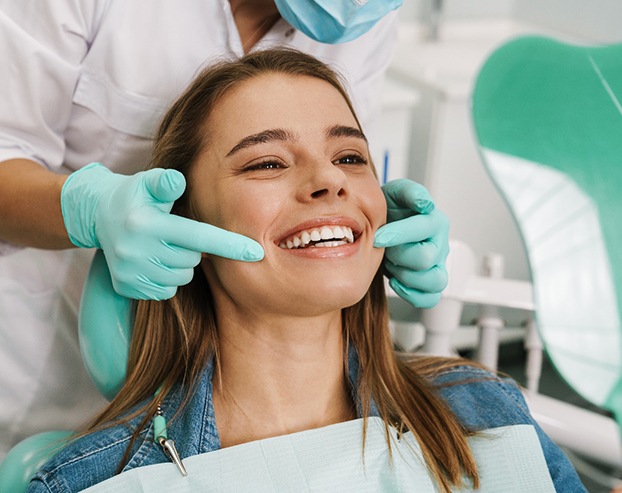
Straightening your teeth is about more than just appearance. When your bite is aligned it’s easier to clean your teeth and gums, chew, and even speak clearly. With Invisalign, your treatment will take less time than it would have with traditional braces, and because your aligners are removable, they are easier to clean, have no dietary restrictions, and are generally a lot more comfortable than wire and bracket braces, too.
Non-Invasive Treatment
Invisalign is less invasive than traditional braces because with aligners, there are fewer adjustments needed to your daily life to care for them. You can still brush and floss your teeth as you normally do, continue eating your favorite foods without restrictions, and even attend important events without feeling insecure about speaking or smiling and revealing a mouthful of wires and brackets.
Plus, it has the added advantage of requiring shorter check-ins with your Devonshire Dental of Boston team, so it will take minimal time away from your busy schedule.
Discreet Trays
Let’s face it; wearing braces can make both teens and adults feel a little self-conscious. Thankfully, Invisalign’s clear aligners are much more discreet than traditional braces. In fact, others may not be able to tell you’re even wearing them! Better still, if you’re scheduled to attend an important social event your braces won’t be the focus of every photo, and you can even remove them temporarily if you need to give a speech or presentation.
Improved Comfort
When it comes to comfort, there’s no better way to straighten your teeth than Invisalign. That’s because unlike with traditional braces, Invisalign aligners are smooth, so there are no wires or brackets poking or scraping against your lips or cheeks, and no need for dental wax, either!
The only discomfort most patients feel is when they switch to a new set of aligners. Because these will fit more snugly than your older ones, the extra pressure on your teeth could cause some soreness or tenderness, but this can be easily managed with OTC pain medications like acetaminophen or ibuprofen. Better still, the duration of soreness is a lot faster than with traditional braces; typically lasting only a day or two.
Better Dental Hygiene
Keeping traditional braces clean is a full-time endeavor. You need to floss between and around your orthodontic equipment every time you eat, or you could be sporting remnants of your meal every time you smile!
Conversely, while it is necessary to brush and floss more frequently with Invisalign, your aligners can be removed for meals and hygiene, so there’s no equipment to clean around when you do. This means it’s not only easier to care for your teeth and gums, but you are also less likely to develop cavities and gum disease during treatment, and you won’t need to buy any special equipment to care for your equipment properly.
Boosted Self-Confidence
One of the perks of a straight, even smile is the boost in self-esteem you get when you share it with the world. Because Invisalign aligners are transparent, they are much less noticeable than traditional braces, making it easier to smile with confidence and maintain a professional appearance during treatment.
For teen patients, Invisalign can help them feel less anxious than they might with traditional braces, which is especially important during those crucial social development years.
Quick Follow-Ups
Because there are no wire changes, your check-in appointments at Devonshire Dental of Boston are much quicker with Invisalign. Typically, your dentist will only need to see you every six to eight weeks, for around 15 to 30 minutes total. Furthermore, the appointments are much more comfortable than traditional orthodontic appointments, as they are done simply to check that your teeth are on track with their treatment timeline as anticipated.
Understanding the Cost of Invisalign
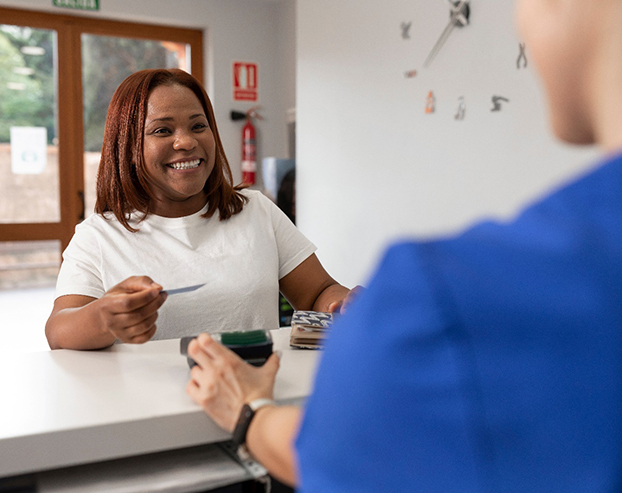
The only way to know how much Invisalign will cost will be to schedule an initial consultation with our dental office. Several factors can affect your specific treatment, such as the severity of your misalignment and the number of aligners you’ll need. Our team will evaluate your dental situation, determine the necessary process to achieve your best results, and inform you of the overall cost. If you wish to know more about what you can expect from Invisalign, or how to make the most of your budget, then feel free to reach out to us today!
Factors That Impact the Cost of Invisalign
There are three main factors that we’ll take into account when determining the cost of Invisalign in Boston:
- Number of Aligners Needed: The primary factor is going to be the number of Invisalign trays you’ll need in order to reach your ideal results. This largely depends on the complexity of your orthodontic issues. For example, extensive bite misalignment will likely require more trays to fix than minor crowding.
- Whether Both Arches are Being Straightened: In some cases, although rarely, your dentist in Boston may only recommend straightening a single arch. This will be less costly than both arches as it will require half the number of aligners.
- Compliance with Treatment: Breaking, losing, or otherwise damaging an aligner can set back your treatment timeline as well as possibly require you to pay for a replacement.
- Additional Accessories: In some cases, Invisalign treatment may involve elastics, chewies, or other accessories to help your teeth move more predictably.
Invisalign vs. Smile Direct Club™: What’s the Best Value?
Although Smile Direct Club™ may have the lower up-front cost, it’s important to consider the treatment as a whole and its value. Not only is the process not overseen by a professional, but these mail-order trays are created based on impressions that you collect at home, which may not be accurate. This can lead to a variety of possible complications, ranging from spacing problems to a lack of blood flow to the gums. Ultimately, it’s best to invest in a higher-quality treatment that will provide you with wonderful results that you can trust.
Will Dental Insurance Cover Invisalign Treatment?
While some dental insurance plans cover the cost of orthodontics for adults and teens, others don’t. This largely depends on the type of coverage you opted-in for and your individual plan’s details. Our team is happy to help you get the most out of your insurance and minimize your out-of-pocket costs in any way we can. We’re proudly in-network with several major PPO plans, including Delta Dental Premier, BlueCross BlueShield, Cigna, and more.
Invisalign FAQs
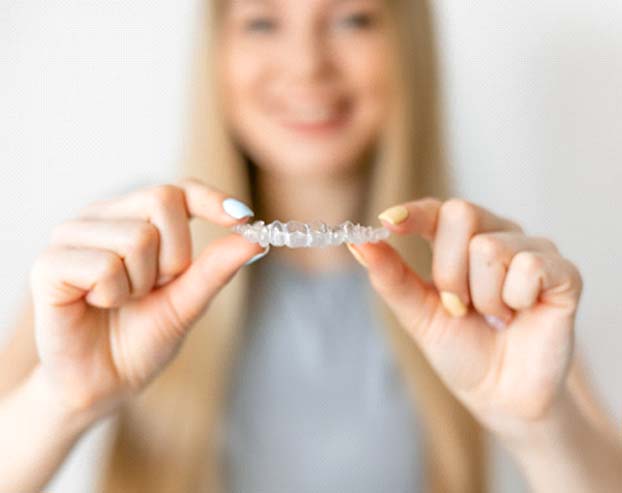
Want to learn more about Invisalign in Boston? Good news: our team is here to help! For specific questions, we encourage you to call our team or to write them down and bring them with you to your consultation. If you simply want to learn a bit more about the process, timelines, and what you can eat with Invisalign, then keep reading.
How Long Does Invisalign Take?
If you’re curious about the length of time you’ll need to commit to Invisalign, then it’s best to schedule a consultation. That way, our Boston cosmetic dentist can assess the severity of your misalignment, how many trays you’ll need, and other important factors to determine your treatment timeline. With all that said, the average time it takes to complete Invisalign is 12-18 months (which is quite quick considering traditional braces can take 24+ months). The best way to stay on track with your treatment plan and work through your series of aligners on time is by following all of your dentist’s instructions, like wearing the trays for 22 hours a day.
Does Invisalign Hurt?
If you’re worried about Invisalign being painful, you can take a breath; it isn’t. Since each tray is custom-made and doesn’t have any brackets or wires, they are considerably more comfortable than traditional braces. While you will likely experience some soreness immediately following the transition to a new set of aligners, you can easily alleviate it will a cold compress, an over-the-counter pain-reliever, or a mixture of the two.
What Happens After Invisalign?
Following your Invisalign treatment, you’ll be given a retainer. Don’t worry – there are clear options that are just as discreet as your Invisalign aligners to avoid drawing unwanted attention to your smile. While the exact guidelines will vary depending on your dental needs, there is a good chance you’ll be asked to wear yours as much as possible for the first six months or so. Once your teeth have “set,” you’ll get the green light from your dentist to begin slowly transitioning to wearing them only at night. To prevent orthodontic relapse, it’s best to make this a lifelong habit.
Can You Eat with Invisalign?
While you can’t eat while they are in your mouth, you can eat whatever you’d like while they are out. That’s one of the many perks of Invisalign – no dietary restrictions! Of course, it’s best to continue to stick to vitamin-rich foods that will help keep your teeth and gums healthy, like fresh fruit, cooked vegetables, filling carbs, and lean proteins. Note: it’s of the utmost importance that you rinse off your aligners and place them in their designated storage case (not a napkin!) while you’re eating to avoid accidentally losing or misplacing them.
Does Invisalign Give You a Lisp?
When you first get your aligners, you may experience a slight lisp. However, it’s worth noting that a large number of patients don’t experience any changes to their speaking patterns. Plus, those that do can have peace of mind knowing the adjustment period will be short. To expedite the process, try reading out loud. While you’re in the car, doing chores, or have some downtime, you can count from 60 to 90 – this will help you practice some of the more difficult to pronounce words.